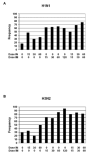A dose-response evaluation of inactivated influenza vaccine given intranasally and intramuscularly to healthy young adults
- PMID: 17559990
- PMCID: PMC2063441
- DOI: 10.1016/j.vaccine.2007.05.002
A dose-response evaluation of inactivated influenza vaccine given intranasally and intramuscularly to healthy young adults
Abstract
Epidemic influenza occurs annually throughout the world and is accompanied by excess morbidity and mortality. Increasing the antigen content and topical administration of vaccine are two strategies being explored to improve the immune responses to trivalent inactivated influenza vaccine (TIV). We conducted a randomized, double-blind, placebo-controlled trial to compare the immunogenicity and reactogenicity of intramuscular (IM), intranasal (IN), or combined IM and IN administration of a contemporary US vaccine formulation at escalating dosage levels in young healthy adults. Two hundred forty three healthy adults between the ages of 18 and 45 years received 15, 30, or 60mcg of trivalent inactivated influenza vaccine by either IN, IM or both routes, 120mcg of vaccine IM, or placebo IN and IM. All dosages and routes of vaccine administration were well-tolerated. A bad taste and mild nasal discomfort were more likely to be reported when influenza vaccine was administered IN, while arm tenderness was more common after IM administration. Significant increases in geometric mean serum antibody titers in both HAI and Nt assays were seen in all of the groups receiving influenza vaccine for all test antigens (P<or=.025, paired t-test), except for the B HAI antibody titer in the group that received 30mcg IN (P=.055, paired t-test). Postvaccination geometric mean serum antibody titers, the frequency of seroresponses, and the percentage achieving postvaccination serum HAI antibody titers of >or=32 were higher following delivery of the study vaccines by an IM route than by the IN route, but significant increases in serum antibody were seen after IN vaccination. Nasal IgA antibody responses were more common when vaccine was administered IN; and, when the IN dosage was increased, the primary benefit from IN vaccine over IM vaccine appeared to be greater induction of nasal secretory antibody.
Figures
Similar articles
-
Comparison of the immunogenicity and safety of a split-virion, inactivated, trivalent influenza vaccine (Fluzone®) administered by intradermal and intramuscular route in healthy adults.Vaccine. 2011 Aug 5;29(34):5666-74. doi: 10.1016/j.vaccine.2011.06.010. Epub 2011 Jun 23. Vaccine. 2011. PMID: 21699951 Free PMC article. Clinical Trial.
-
Immunization with trivalent inactivated influenza vaccine in partially immunized toddlers.Pediatrics. 2006 Sep;118(3):e579-85. doi: 10.1542/peds.2006-0201. Pediatrics. 2006. PMID: 16950949 Clinical Trial.
-
Phase I evaluation of intranasal trivalent inactivated influenza vaccine with nontoxigenic Escherichia coli enterotoxin and novel biovector as mucosal adjuvants, using adult volunteers.J Virol. 2006 May;80(10):4962-70. doi: 10.1128/JVI.80.10.4962-4970.2006. J Virol. 2006. PMID: 16641287 Free PMC article. Clinical Trial.
-
Randomized Controlled Trial to Compare Immunogenicity of Standard-Dose Intramuscular Versus Intradermal Trivalent Inactivated Influenza Vaccine in HIV-Infected Men Who Have Sex With Men in Bangkok, Thailand.Clin Infect Dis. 2016 Feb 1;62(3):383-391. doi: 10.1093/cid/civ884. Epub 2015 Oct 20. Clin Infect Dis. 2016. PMID: 26486702 Free PMC article. Clinical Trial.
-
Safety, reactogenicity and immunogenicity of an intranasal seasonal influenza vaccine adjuvanted with gram-positive matrix (GEM) particles (FluGEM): A randomized, double-blind, controlled, ascending dose study in healthy adults and elderly.Vaccine. 2024 Sep 17;42(22):125836. doi: 10.1016/j.vaccine.2024.03.063. Epub 2024 May 20. Vaccine. 2024. PMID: 38772837 Clinical Trial.
Cited by
-
An adjuvant for the induction of potent, protective humoral responses to an H5N1 influenza virus vaccine with antigen-sparing effect in mice.J Virol. 2010 Sep;84(17):8639-49. doi: 10.1128/JVI.00596-10. Epub 2010 Jun 10. J Virol. 2010. PMID: 20538850 Free PMC article.
-
PCEP enhances IgA mucosal immune responses in mice following different immunization routes with influenza virus antigens.J Immune Based Ther Vaccines. 2010 Aug 24;8:4. doi: 10.1186/1476-8518-8-4. J Immune Based Ther Vaccines. 2010. PMID: 20735838 Free PMC article.
-
Influenza Chimeric Protein (3M2e-3HA2-NP) Adjuvanted with PGA/Alum Confers Cross-Protection against Heterologous Influenza A Viruses.J Microbiol Biotechnol. 2021 Feb 28;31(2):304-316. doi: 10.4014/jmb.2011.11029. J Microbiol Biotechnol. 2021. PMID: 33263336 Free PMC article.
-
The dichotomy of pathogens and allergens in vaccination approaches.Front Microbiol. 2014 Jul 16;5:365. doi: 10.3389/fmicb.2014.00365. eCollection 2014. Front Microbiol. 2014. PMID: 25076945 Free PMC article. Review.
-
Vaccine Strategies to Elicit Mucosal Immunity.Vaccines (Basel). 2024 Feb 13;12(2):191. doi: 10.3390/vaccines12020191. Vaccines (Basel). 2024. PMID: 38400174 Free PMC article. Review.
References
-
- Smith NM, Bresee JS, Shay DK, Uyeki TM, Cox NJ, Strikas RA. Prevention and Control of Influenza: recommendations of the Advisory Committee on Immunization Practices (ACIP) MMWR Recomm Rep. 2006;55:1–42. - PubMed
-
- Barker WH, Mullooly JP. Influenza vaccination of elderly persons. Reduction in pneumonia and influenza hospitalizations and deaths. JAMA. 1980;244:2547–9. - PubMed
-
- Keitel WA, Atmar RL, Cate TR, et al. Safety of high doses of influenza vaccine and effect on antibody responses in elderly persons. Arch Intern Med. 2006;166:1121–7. - PubMed
-
- Keitel WA, Couch RB. Inactivated influenza vaccines. In: Potter CW, editor. Influenza. New York: Elsevier; 2002. pp. 145–77.
-
- Gross PA, Quinnan GV, Jr, Weksler ME, Gaerlan PF, Denning CR. Immunization of elderly people with high doses of influenza vaccine. J Am Geriatr Soc. 1988;36:209–12. - PubMed
Publication types
MeSH terms
Substances
Grants and funding
LinkOut - more resources
Full Text Sources
Medical
Research Materials
Miscellaneous


